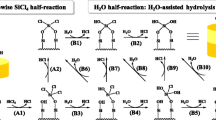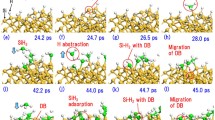Abstract
High-order silane precursors, including trisilane, are candidates for the low-temperature epitaxy process owing to the low energy of Si–Si bond. Higher order silanes are regarded as being more reactive than lower order ones. We compared the SiGe epitaxial growth behaviors of high-order silane precursors on Si substrates in an ultra-high vacuum chemical vapor deposition chamber without a carrier gas. SiGe epitaxial layers with a thickness of 25 nm or more were grown using disilane, trisilane, or tetrasilane precursor at 500 °C. Interestingly, trisilane exhibited more severe island formation than tetrasilane, which has higher reactivity than trisilane, even at lower partial pressure. These islands were not eliminated by lowering pressure but could be suppressed by higher Ge content owing to enhanced surface diffusion.







Similar content being viewed by others
Availability of data and material
Not applicable.
Code availability
Not applicable.
References
C. Porret, A. Hikavyy, J.F.G. Granados, S. Baudot, A. Vohra, B. Kunert, B. Douhard, J. Bogdanowicz, M. Schaekers, D. Kohen, J. Margetis, J. Tolle, L.P.B. Lima, A. Sammak, G. Scappucci, E. Rosseel, R. Langer, R. Loo, Very low temperature epitaxy of group-IV semiconductors for use in FinFET, stacked nanowires and monolithic 3D integration. ECS J. Solid State Sci. Technol. 8, 392 (2019). https://doi.org/10.1149/2.0071908jss
A. Hikavyy, I. Zyulkov, H. Mertens, L. Witters, R. Loo, N. Horiguchi, Use of high order precursors for manufacturing gate all around devices. Mater. Sci. Semicond. Process. 70, 24 (2017). https://doi.org/10.1016/j.mssp.2016.10.044
D.J. Paul, Si/SiGe heterostructures: from material and physics to devices and circuits Semiconductor science and technology. Semicond. Sci. Technol. 19(10), R75 (2004). https://doi.org/10.1088/0268-1242/19/10/R02
C.C. Yang, T.Y. Hsieh, W.H. Huang, C.H. Shen, J.M. Shieh, W.K. Yeh, M.C. Wu, Recent progress in low-temperature-process monolithic three dimension technology. Japanese J. Appl. Phys. 57(4S), 04FA06 (2018). https://doi.org/10.7567/JJAP.57.04FA06
Y.R. Luo, Handbook of Bond Dissociation Energies in Organic Compounds (CRC Press, Boca Raton, 2003).
T.N. Adam, S. Bedell, A. Reznicek, D.K. Sadana, A. Venkateshan, T. Tsunoda, T. Seino, J. Nakatsuru, S.R. Shinde, Low-temperature growth of epitaxial (1 0 0) silicon based on silane and disilane in a 300 mm UHV/CVD cold-wall reactor. J. Cryst. Growth 312, 3473 (2010). https://doi.org/10.1016/j.jcrysgro.2010.09.012
J.M. Hartmann, V. Benevent, J.F. Damlencourt, T. Billon, A benchmarking of silane, disilane and dichlorosilane for the low temperature growth of group IV layers. Thin Solid Films 520, 3185 (2012). https://doi.org/10.1016/j.tsf.2011.10.164
P.R. Fischer, M. Bauer, S.R.A. Van Aerde, T.G.M. Oosterlaken, M. Yan, W.A. Verweij, B.W.M. Bozon, P.M. Zagwijn, Low temperature Silcore® deposition of undoped and doped silicon films. ECS Trans. 3, 203 (2006). https://doi.org/10.1149/1.2356280
A. Gouyé, O. Kermarrec, A. Halimaoui, Y. Campidelli, D. Rouchon, M. Burdin, P. Holliger, D. Bensahel, Low-temperature RPCVD of Si, SiGe alloy, and Si1−yCy films on Si substrates using trisilane (Silcore®). J. Cryst. Growth. 311, 3522 (2009). https://doi.org/10.1016/j.jcrysgro.2009.04.011
B. Vincent, R. Loo, W. Vandervorst, G. Brammertz, M. Caymax, Low temperature Si homo-epitaxy by reduced pressure chemical vapor deposition using dichlorosilane, silane and trisilane. J. Cryst. Growth. 312, 2671 (2010). https://doi.org/10.1016/j.jcrysgro.2010.06.013
M. Shinriki, K. Chung, S. Hasaka, P. Brabant, H. He, T.N. Adam, D. Sadana, Gas phase particle formation and elimination on Si (100) in low temperature reduced pressure chemical vapor deposition silicon-based epitaxial layers. Thin Solid Films 520, 3190 (2012). https://doi.org/10.1016/j.tsf.2011.10.165
R. Hazbun, J. Hart, R. Hickey, A. Ghosh, N. Fernando, S. Zollner, T.N. Adam, J. Kolodzey, Silicon epitaxy using tetrasilane at low temperatures in ultra-high vacuum chemical vapor deposition. J. Cryst. Growth. 444, 21 (2016). https://doi.org/10.1016/j.jcrysgro.2016.03.018
J. Hart, R. Hazbun, D. Eldridge, R. Hickey, N. Fernando, T.N. Adam, S. Zollner, J. Kolodzey, Tetrasilane and digermane for the ultra-high vacuum chemical vapor deposition of SiGe alloys. Thin Solid Films 604, 23 (2016). https://doi.org/10.1016/j.tsf.2016.03.010
K.H. Chung, N. Yao, J. Benziger, J.C. Sturm, K.K. Singh, D. Carlson, S. Kuppurao, Ultrahigh growth rate of epitaxial silicon by chemical vapor deposition at low temperature with neopentasilane. Appl. Phys. Lett. 92, 113506 (2008). https://doi.org/10.1063/1.2897325
J.C. Sturm, K.H. Chung, Chemical vapor deposition epitaxy of silicon-based materials using neopentasilane. ECS Trans. 16, 799 (2008). https://doi.org/10.1149/1.2986839
P.M. Garone, J.C. Sturm, P.V. Schwartz, S.A. Schwarz, B.J. Wilkens, Silicon vapor phase epitaxial growth catalysis by the presence of germane. Appl. Phys. Lett. 56, 1275 (1990). https://doi.org/10.1063/1.102535
A. Abedin, M. Moeen, C. Cappetta, M. Östling, H.H. Radamson, Sensitivity of the crystal quality of SiGe layers grown at low temperatures by trisilane and germane. Thin Solid Films 613, 38 (2016). https://doi.org/10.1016/j.tsf.2015.10.001
J.G. Martin, H.E. O’Neal, M.A. Ring, Thermal decomposition kinetics of polysilanes: disilane, trisilane, and tetrasilane. Int. J. Chem. Kinet. 22, 613 (1990). https://doi.org/10.1002/kin.550220606
M.T. Swihart, S.L. Girshick, Thermochemistry and kinetics of silicon hydride cluster formation during thermal decomposition of silane. J. Phys. Chem. B. 103, 64 (1999). https://doi.org/10.1021/jp983358e
A.A. Onischuk, V.N. Panfilov, Mechanism of thermal decomposition of silanes. Russ. Chem. Rev. 70, 321 (2001). https://doi.org/10.1070/RC2001v070n04ABEH000603
Acknowledgements
The authors thank SK Materials for providing the high-order silane precursors. We would like to thank Editage (https://www.editage.co.kr) for English language editing.
Funding
This work was supported by the Future Semiconductor Device Technology Development Program (20004274) funded by the Ministry of Trade, Industry & Energy (MOTIE), and the Technology Innovation Program (20010598) funded by the Ministry of Trade, Industry & Energy (MOTIE) and Korea Semiconductor Research Consortium (KSRC).
Author information
Authors and Affiliations
Corresponding author
Ethics declarations
Conflict of interest
The authors declare that they have no conflict of interest.
Ethical approval
Not applicable.
Additional information
Publisher's Note
Springer Nature remains neutral with regard to jurisdictional claims in published maps and institutional affiliations.
Rights and permissions
About this article
Cite this article
Byeon, DS., Choi, Y., Cho, C. et al. Comparison of high-order silanes and island formation phenomena during SiGe epitaxy at 500 °C. J. Korean Phys. Soc. 78, 712–718 (2021). https://doi.org/10.1007/s40042-021-00134-x
Received:
Revised:
Accepted:
Published:
Issue Date:
DOI: https://doi.org/10.1007/s40042-021-00134-x




